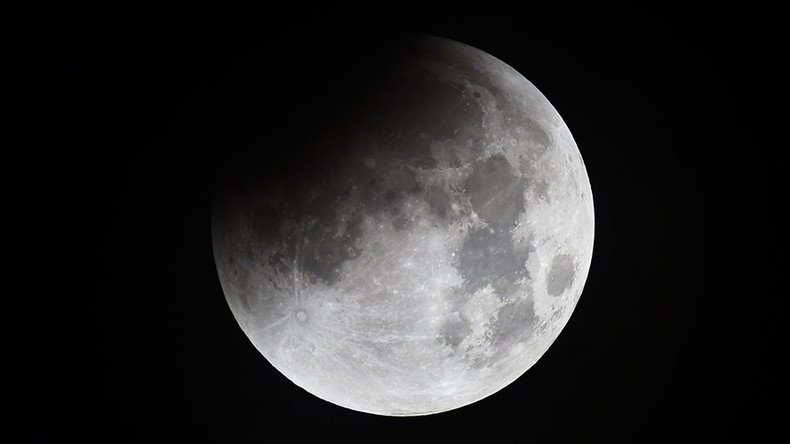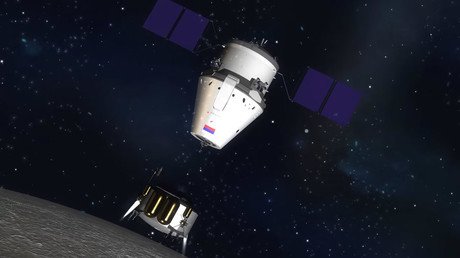Russian space rocket corporation Energia has unveiled draft plans for a new reusable space vehicle to shuttle cargo and crews between the Space Station and the moon. The new spacecraft called ‘Ryvok’ or ‘Charge’ would greatly cut the costs of the lunar trip.
The “Ryvok” (Charge of Breakthrough) project has been unveiled at the Human Space Exploration international conference in the city of Korolev located near Moscow – a first-of-its-kind event hosted by Roscosmos with the cooperation of the International Academy of Astronautics (IAA).
According to Energia’s plans, the new spacecraft will be permanently based on the ISS – or its descendant – and will serve as the mid-way shuttle for delivering cargo and crews to the moon, previously brought up to the Earth’s orbit by the time-tested and trustworthy Soyuz series ships and the cutting edge Angara series rockets.
To power each flight, Ryvok will rely on a modernized standard accelerator block, which will be delivered into orbit by the Angara A5 heavy-lift launch system separately. The expendable accelerator will be used to provide the necessary thrust power for Ryvok to reach moon on a journey that would last about five days.
For a smooth docking back to the orbital Space Station, the module will come equipped with a 55 square meter “umbrella” needed to reduce Ryvok’s speed on a return journey to Earth.
The Russian developer believes that Ryvok will be much more cost efficient compared to the Federation, another new-generation manned spacecraft that Energia is currently developing to tow both humans and cargo to Earth’s orbit and potentially the moon.
“The cost of the Ryvok reusable manned spacecraft mission is a third lower than the costs of the Federation manned transport spacecraft mission,” Energia's representative Yuri Makushenko told international delegations.
The development of the Federation, formerly known as the Prospective Piloted Transport System (PPTS), is expected to be completed in 2021. Its first launches to the International Space Station (ISS), in both manned and unmanned modes, are scheduled for 2023.The spacecraft will have a crew of up to four people and will be able to operate autonomously for up to 30 days. It can be deployed to the ISS for up to one year.
The advantages of Ryvok over Federation, Makushenko noted, is the absence of the need to wait for the development of a super-heavy launch vehicle Angara A5V with an oxygen-hydrogen booster. The new project would also reduce the time needed to create the national space transportation system. Makushenko also said that because Angara rockets will only be used in the scheme to deliver the accelerators and not humans, it will be much easier to get all the certification approvals.
Overall the Russian space agency, Roscosmos, envisions its first spacecraft to be capable of reaching the Moon in 2024-2025, while the first actual flight to the Moon is planned for after 2025.
The Human Space Exploration conference which is hosting more than 350 engineers, astronauts and employees from space agencies kicked off on Tuesday. The enhancing of the exploration of Mars and the moon are key points on the agenda of space agencies, participants of the conference told RT shedding light on their future projects.
Thomas Reiter, astronaut and Director of the European Space Agency (ESA) Directorate of Human Spaceflight and Operations said that ESA is already envisioning the so-called “moon village” concept.
“Here we are in the cooperation with Roskosmos on robotic mission, because we think the moon is an excellent destination for itself. [It has] good scientific reasons. It can probably provide resources if we find water, ice… we can generate oxygen, hydrogen, fuel for engines,” Reiter said. “It can be a platform for further explorations and indeed moon village will be a very interesting concept…”
The prospects of furthering exploration on Mars or its “surroundings” also remain high.
“[There are] lots of activities internationally ongoing, lots of missions, and now cooperation between Russia and European space agency with the successful launch of exomars will reach the orbit of the planet in October, and then in 2020 next mission with the rover will be launched. Of course, we are thinking about what would be the next step. Should we go first to one of the moons of Mars, or would we go to eternal surface of Mars,” Reiter said.
Mark Mulqueen, ISS Program Manager regards Mars as a main destination “just because it’s probably the best environment for us to have future life and future subsidence on the planet for the human race to continue”.
“We’ll allow humans to travel to the Mars’ moons and orbit… and then ascend back to our platform and return to a habitation module which will than transfer back to cislunar,” Mulqueen said.He assured that with the “joint effort of mankind” safe travels to various destinations in space will “be a reality”.
RT has also spoken to the first Chinese astronaut sent into space, who said he “felt proud for the whole of mankind and for his country” when he saw Earth for the first time from outer space.
Commenting on China’s plans regarding space exploration Liwei said that the country is currently working on building its own space station “which is to start functioning in 2022 and is to be working for no less than 10 years.”
The conference, held to mark the 55th anniversary of the first manned flight into space by Yuri Gagarin, is set to last until Thursday.


